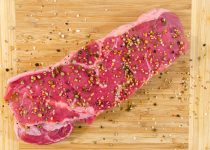Mastering Backyard Barbecue With Matt Pittman: 3 Steps to Perfect Prime Rib
To ace your backyard barbecue prime rib, start by choosing a bone-in cut with lots of marbling. This guarantees it's both juicy and flavorful. Next, marinate your prime rib overnight with olive oil, garlic, and herbs, and let it come to room temperature before grilling. This will help the flavors penetrate deeply and the meat cook evenly. Finally, master your grill's temperature. If you're using a gas grill, aim for a steady medium heat, around 325°F. For charcoal lovers, get skilled at managing your heat distribution. Stick to these steps, and you'll serve up a prime rib that's hard to beat. Ready for more tips?
Table of Contents
Key Takeaways
- Select a bone-in prime rib with good marbling for flavor and juiciness.
- Marinate with olive oil, garlic, and herbs overnight to enhance flavor.
- Allow the marinated prime rib to reach room temperature before grilling.
- Use two-zone grilling on a charcoal grill for searing and gentle cooking.
- Maintain a steady medium heat around 325°F on a gas grill for even cooking.
Selecting the Right Cut
Choosing the right cut is crucial; opt for a bone-in prime rib to ensure maximum flavor and juiciness. But hey, don't just grab any prime rib off the shelf. You've gotta dive deeper. Let's talk marbling and aging, two key players that can make or break your barbecue masterpiece.
Marbling, that's the fat woven within the muscle, and trust me, it's your best friend for moisture and flavor. Look for cuts with a good amount of white flecks throughout. This fat melts as it cooks, naturally basting the meat from the inside. In essence, more marbling equals a juicier, more flavorful bite. Don't skimp on this; it's what separates the unforgettable meals from the just okay.
Now, onto the aging process. Aged beef? It's like letting a fine wine mature; it only gets better. Aging allows enzymes to break down the muscle tissues, tenderizing the meat and enhancing the flavors. If you can find a dry-aged prime rib, you're golden. The aging process concentrates the flavors and softens the meat, making your prime rib not just tender, but legendary.
Preparing Your Prime Rib
Once you've got your prime rib, it's time to get it prepped for the grill. First things first, you're gonna want to think about your seasoning choices and marinating techniques. These steps are important for infusing your meat with flavors that'll stand out after it's cooked.
When it comes to seasoning, you've got a range of options, from simple salt and pepper to a more elaborate rub. Here's a handy table to help you decide:
| Ingredient | Quantity for 5 lbs of Prime Rib | Purpose |
|---|---|---|
| Salt | 3 tbsp | Enhances natural beef flavor |
| Black Pepper | 2 tbsp | Adds a spicy kick |
| Garlic Powder | 1 tbsp | Gives a rich, earthy taste |
| Rosemary | 2 tsp, chopped | Adds a fragrant, herby note |
Marinating is all about letting those flavors soak into the meat. You might want to whip up a marinade with olive oil, crushed garlic, and your choice of herbs. Let the prime rib sit in this marinade overnight in the fridge. Remember, the longer it marinates, the deeper the flavors will penetrate. Just make sure to bring it back to room temperature before it hits the grill. This step is key for even cooking. Now, you're all set to impress with that flavorful, juicy prime rib.
Mastering the Grill Temperature
Now that your prime rib is marinated and ready for the grill, let's focus on getting the temperature just right. Nailing this is essential because too hot or too cold, and you'll end up with less than stellar results. You want perfection, right?
First off, consider your fuel choices. Are you using charcoal or gas? Charcoal can give you that unbeatable smoky flavor, but it requires you to master the art of heat distribution. Spread the coals evenly or set up a two-zone grill, with one side hot and the other cooler. This setup allows you to sear the meat over direct heat, then let it cook through more gently.
If you're on a gas grill, it's all about control. Maintain a steady medium heat, around 325°F. Gas grills are great for keeping a consistent temperature, but keep an eye on those burners and make adjustments as needed to avoid hot spots.
Frequently Asked Questions
Can I Use an Electric Smoker for Prime Rib?
Yes, you can use an electric smoker for prime rib. It offers precise temperature control and lets you experiment with wood choice to enhance the flavor, essential for achieving that perfect, smoky taste.
What Are Alternative Spices to Traditional Rubs?
You can try herbal infusions or citrus zest instead of traditional rubs. They'll add a fresh, bold flavor to your prime rib, enhancing its taste without overpowering the natural meaty flavors.
How Do I Barbecue Prime Rib in Winter?
To barbecue prime rib in winter, you'll need to prioritize winter grill maintenance and master cold weather techniques. Make sure your grill's well-insulated and preheated to combat the lower temperatures effectively.
Is Marinating Prime Rib Overnight Necessary?
No, marinating prime rib overnight isn't necessary, but it does enhance the flavor depth greatly. You'll notice a richer taste if you let those spices soak in, giving you an edge in your barbecue mastery.
What Vegetarian Dishes Complement Barbecue Prime Rib?
You'll want to serve grilled vegetables and stuffed mushrooms with your barbecue prime rib. They're easy to master and perfectly complement the meat's rich flavors while keeping things fresh and balanced.



